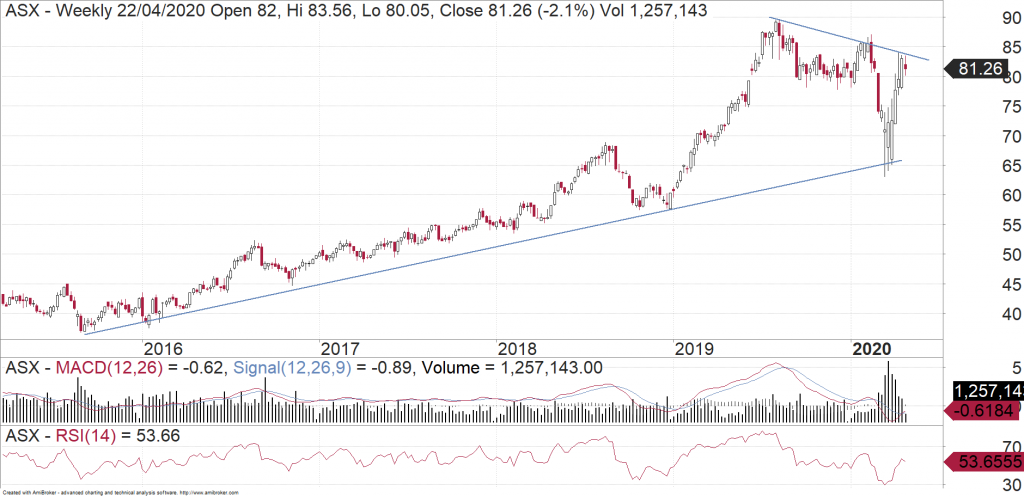ASX Ltd (ASX:ASX) possesses a number of defensive characteristics that stand out in light of the current COVID-19 outbreak. These include a strong correlation to falling Australian 10-year bond yields, the absence of any balance sheet risk (as the Company is debt-free), earnings being somewhat insulated during risk-off events and finally, increased futures trading as interest rates are cut.
Further, the Company’s monopoly position in key markets allows for price increases in future years as equity market conditions improve.
About ASX Ltd
ASX Ltd operates Australia’s primary market for the listing and trading of securities. The Company has a monopoly position in this market and is also the single provider of cash equities and derivatives execution in Australia, clearing and settlement services and the dominant provider of clearing and settlement services for debt and money market securities.
After Chi-X launched its rival exchange in 2011, the only real competition that ASX faces is in secondary market cash equities trading, which accounts for only ~6% of group revenue. ASX also earns revenue by charging for access to its IT infrastructure and provision of market data, as well as interest and dividend income. The Company’s customer base is diverse and includes issuers (i.e. corporations and trusts), financial products, investment and trading banks, fund managers, commodity trading advisers, brokers and proprietary traders, market data vendors and retail investors.
Key Fundamental Drivers
1. Higher Collateral Balances to Offset Headwind from Lower Cash Rates
Net Interest income is generated mainly from net interest earned on collateral balances. This accounted for 86% of overall net interest income, with the remainder generated from group net interest income, which is leveraged to the RBA cash rate.
Collateral balances are typically hard to predict, but ASX expects them to remain elevated near term. This seems to be a reasonable prediction given continued volatility in rates and solid levels of open derivative positions held at the clearing house.
The further reduction in the RBA cash rate to 0.25% is expected to keep group net interest income subdued. However, as group net interest income is a relatively lower portion of overall net interest income, the steady contribution expected from net interest earned on collateral balances ensures that net interest income will continue to provide a boost to group pre-tax profit.
2. High Margin and Ability to Moderate Cost Growth
The Company has a solid track record on cost control, which has enabled the Company to maintain high EBIT margins (~70%) over the past decade. During periods where there has been EBITDA margin pressure arising from cost growth exceeding revenue growth, there has been an immaterial impact on net profit after tax, given that ASX generates such a high EBIT margin and also generates net interest income (i.e. pre-tax profit is higher that EBIT) that supports earnings at the underlying profit after tax level.
In light of the COVID-19 outbreak, the Company has flagged a significant decline in cost growth for FY20, to be below guidance of 6-8%.
3. Conservative Use of Cash Balance
ASX has a strong cash balance, with a debt-free balance sheet. Operating cashflow is typically strong enough to cover CAPEX requirements and maintain a dividend payout ratio of at least 90%. The Company does not have an apparent appetite for acquisitions, preferring to allocate capital towards meeting CAPEX requirements (for example, the current investment into technology over the medium term), as well as the payment of dividends (including special dividends).
Fundamental View
ASX shares are currently trading on a 1-year forward P/E multiple in excess of 30x. While this appears unattractive in the context of a low- to mid-single digit EPS growth profile over the medium term, we consider that ASX is likely to continue to outperform the broader market in light of the current uncertainty.
Charting View
ASX has shown some bullish signs in the last few weeks by rallying strongly and closing near its weekly highs. It therefore appears as though there is good support back near the $65 level which is right on the longer term uptrend line. There will be some resistance near current levels so in the short-term it would be better to wait for either a breakout, or for the shares to dip lower. Any dips (provided it holds above $65) would be a buying opportunity.





